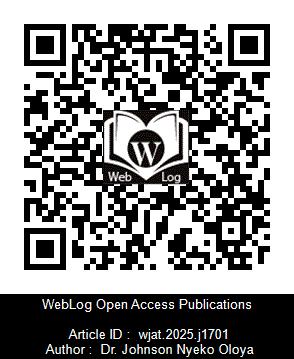
ARTICLE TYPE : RESEARCH ARTICLE
Published on : 17 Oct 2025, Volume - 1
Journal Title : WebLog Journal of Anatomy | WebLog J Anat
Source URL: ![]() https://weblogoa.com/articles/wjat.2025.j1701
https://weblogoa.com/articles/wjat.2025.j1701
Permanent Identifier (DOI) :  https://doi.org/10.5281/zenodo.17410944
https://doi.org/10.5281/zenodo.17410944
Perceptions and Barriers to Cadaveric Dissection: A Qualitative Study of Medical Students at Makerere University
2Department of Internal Medicine, Faculty of Medicine, Gulu University, Gulu City, Uganda
Abstract
Background: Only 24.4% of students engaged in hands-on dissections, 42.7% observed, and 31.7% relied on manuals. Some cadavers are incompletely dissected, a need for a deeper understanding of medical students’ perceptions and the underlying cause of these behaviors with an of improving engagement and optimizing learning outcomes.
Methods: A qualitative study was conducted with first- and second-year medical students at Makerere University. Data were collected through focus group discussions and analyzed thematically following Braun and Clarke’s inductive approach, continuing until data saturation was achieved.
Results: Thematic analysis of students’ reflections revealed four overarching domains that shaped their experiences with cadaveric dissection. First, Perceptions and Emotional Response captured the spectrum of initial reactions ranging from awe and gratitude to anxiety, nausea, and sensory discomfort highlighting the emotional complexity of first exposure. Second, Challenges and Systemic Issues encompassed logistical constraints, poor specimen quality, overcrowding, and limited psychological preparation, which collectively undermined engagement and academic performance. Third, Ethical Concerns reflected tensions around body donation, cultural beliefs, and institutional transparency, often prompting moral introspection and calls for reform. Finally, Learning Strategies and Adaptation described students’ evolving coping mechanisms, peer support, and reflective practices that facilitated emotional regulation and deeper anatomical understanding over time.
Conclusion: Cadaveric dissection is perceived as essential for achieving anatomical mastery and developing clinical competence, yet it simultaneously evokes considerable emotional discomfort and ethical unease among medical students. Enhancing cadaver quality, providing robust instructional support, coupled with transparent ethical practices and culturally sensitive approaches, can significantly improve student participation, reduce distress, and optimize learning in anatomy programs.
Keywords: Cadaveric Dissection; Medical Education; Perceptions; Barriers to Cadaver Dissections; Anatomy; Emotional Response; Ethical Concerns; Cultural Beliefs; Uganda
Citation
Nyeko Oloya J, Mwarisi Masilili G, Apio E. Perceptions and Barriers to Cadaveric Dissection: A Qualitative Study of Medical Students at Makerere University. WebLog J Anat. wjat.2025. j1701. https://doi.org/10.5281/zenodo.17410944